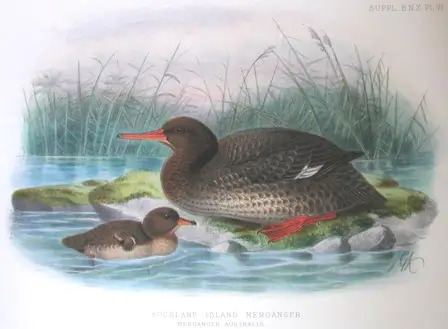Auckland Island merganser
Mergus australis
Anseriformes - Anatidae - Mergus
The Auckland Merganser, a species once distributed in the Auckland Islands south of New Zealand’s South Island, was a typical merganser with the characteristic long, narrow, serrated bill. Male birds had deep reddish-brown heads and necks including the crest, dark bluish black backs and tail feathers, and dark gray wing feathers. Females were slightly smaller with shorter crests.
When Europeans discovered the Auckland Merganser in the mid-19th century, its distribution was quite narrow, found only on two islands in the Auckland Islands. However, fossil evidence indicates they still survived on New Zealand’s South Island in relatively recent historical times. Little is known about their life history, but they are believed to have inhabited small freshwater bodies, although many of their existing specimens were collected near coastal areas. Some accounts mention that when pursued by humans, they preferred to hide among rocks rather than dive to escape like European mergansers (Common Merganser and Red-breasted Merganser).1
The reasons for the Auckland Merganser’s retreat from the South Island to the Auckland Islands, and its eventual extinction, were generally similar. Beyond direct hunting by humans, mammals introduced by humans also destroyed their nests and eggs. The last sighting was on January 9, 1902, when a pair of Auckland Mergansers was shot.
The Auckland Merganser was the only extinct species among the five modern Mergus species, and one of only two merganser species distributed in the Southern Hemisphere, the other being the Brazilian Merganser found in Brazil, currently one of the world’s most endangered waterfowl with an IUCN rating of “Critically Endangered.” The Scaly-sided merganser, distributed in East Asia and wintering in the Yangtze River basin, is rated as “Endangered” by the IUCN. Additionally, subfossil remains of an extinct merganser were discovered on Chatham Island east of New Zealand’s South Island, generally considered to be a separate species that survived until relatively recent times.

-
Errol Fuller, Extinct Birds, New York, Ny U.A.: Facts On File Publ, 1987, p52. ↩︎